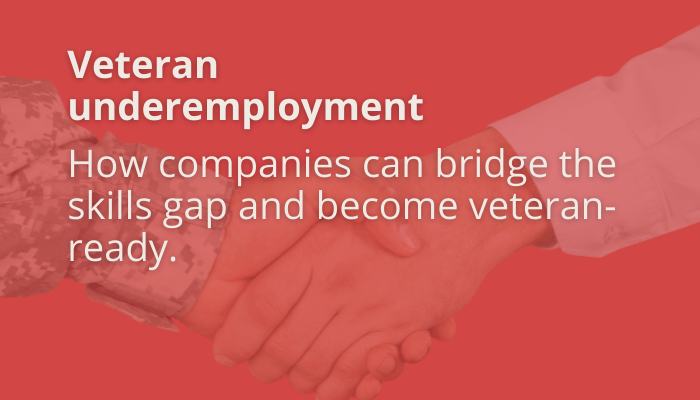
The latest figures from U.S. Department of Labor indicate the unemployment rate for veterans is down from 4.2% in October to just 3.8% as of November, 2021. That’s quite an improvement since the start of the pandemic. But, as the rate of veteran employment has improved, the issue of underemployment has become a leading barrier to meaningful post-service careers for many veterans. Underemployment refers to not having enough paid work, or work that doesn’t make full use of a person’s skills and abilities.
Veterans have much to offer in the private sector. They leave the service with valuable transferable skills. Many are educated, disciplined, professional, self-starters and detail oriented. They have a strong work ethic and are grounded in ethical decision-making — important attributes companies rely upon to build and sustain their good reputations. The leadership and management training many veterans receive while in the service meets or exceeds what corporate America offers. Yet, veterans are underemployed at a rate 15.6% higher than non-veterans. As a result, nearly half of all veterans leave their first post-military position within a year, and between 60% and 80% of veterans leave their first civilian jobs before their second work anniversary.
One reason this figure is so high is because many veterans take the first job available, as opposed to finding something that better matches their skill set and experience. The reason may be due to the transition process itself, which often results in veterans taking jobs they are overqualified for to replace income immediately after service.
While hiring veterans to advance diversity, equity and inclusion objectives is a positive step forward, corporate recruiters and hiring managers may need to explore more deeply how best to match veterans’ skills and experience with their company’s particular business needs. Often, veterans themselves aren’t clear how their service experience best translates to private sector needs.
How can companies learn to bridge the skills gap and establish pathways into their companies that are less traditional and attract and integrate qualified veterans into their workforce?
Leverage your network and existing veteran personnel
Consider how job descriptions are worded and employ existing veteran team members to help identify transferable skills. Encourage them to share open positions within the company to their veteran friends and networks. Also, have veterans within the organization serve as mentors for new recruits. This can be done by creating an employee/veteran resource group (VRG). A VRG can help recruit and retain veteran hires by providing a structured system that veteran employees can rely on for professional engagement, networking, and mentorship. To learn how to build a successful VRG read our recent blog post here. These mentors can help prospective employees translate military skills into skills that civilian employers will understand.
Partner with local non-profit or private sector initiatives
Microsoft’s Military Affairs division created the Microsoft Software and Systems Academy (MSSA), a program designed to help veterans and service members prepare for careers in the tech industry. It has more than 600 corporate hiring partners. After 17 weeks of immersive training in MSSA, graduates emerge ready to enter the workforce and build meaningful careers in technology.
There are also many non-profit veteran organizations who train, mentor and deploy departing service members, preparing them to make the transition to the civilian workforce. One example is the U.S. Chamber of Commerce Foundation’s Hiring Our Heroes Fellowship Program, which connects businesses with accomplished individuals from the military community who are ready to work. Hiring Our Heroes fellowships are designed to provide workforce development programs that place highly skilled and educated service members, veterans, military spouses, and military caregivers with employers who are committed to hiring them.
These types of organizations, while they work with corporate partners all across the country, may be located in the same city a company is located. For companies to maximize long-term and sustainable impact, they can support veterans in their local communities by partnering with one where they are headquartered.
For most hiring managers, sourcing, and hiring employees is only half the battle. Retaining and engaging them is critical. Companies with solid leadership that address the recruitment and retention issue head-on will find that veterans will tend to stay on the job longer. Offering veterans pathways to management, employers will learn that veterans will thrive, are eager and are motivated to take on leadership roles.


